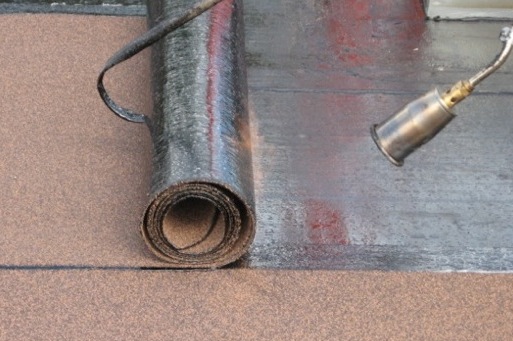
“Modified bitumen” might be an unfamiliar term to many people who aren’t in the roofing industry, but it is a common choice in commercial roofing and other flat or nearly-flat roofs. Bitumen is also known as asphalt, which has been used in roofing for over 100 years. In the 1960s, modified bitumen was developed in order to create a roofing material that has all the physical properties of asphalt along with additional flexibility and weathering benefits of plastic or rubber. BassTech International supplies the roofing industry with the most common bitumen modifiers, SBS (styrene-butadiene-styrene) and APP (atactic polypropylene). SBS is a synthetic rubber, while APP is a plastic.
Here are five interesting facts about modified bitumen roofing systems:
1. Torchdown or peel-and-stick? Depends on whether the bitumen is modified with APP or SBS
APP-modified bitumen is typically torch-applied. The material is rolled out while simultaneously being heated with a torch, which turns the underside of the membrane into a molten adhesive that forms a waterproof bond to the substrate as it cools. SBS-modified bitumen usually comes with the option of cold adhesive or peel-and-stick applications, making it a sensible choice when flammability of the substrate or surrounding materials is a concern.
2. Modified bitumen did away with the need for heavy gravel roof coverings
Before modified bitumen roofing came along, it was common for large flat-roofed buildings to have a heavy coating of gravel as part of the built-up roof (BUR) system. The gravel coating serves the dual purpose of protecting the asphalt from UV rays while weighing it down. Modified bitumen membranes are able to expand and contract with the rest of the roofing layers, and because they adhere directly to the substrate they do not need to be covered with gravel, although they do still need a UV-protective coating. Aside from putting much less weight on the structure, the lack of a heavy gravel or ballast cover can make it easier to find leaks.
3. Foot traffic is one of the leading causes of flat roof damage
Even a properly installed roof can quickly be damaged by foot traffic. Modified bitumen roofing is generally not used for buildings where regular roof activity is anticipated because it can wear away the protective UV coating.
4. Bird droppings are another major cause of flat roof damage
Bird droppings are acidic. Aside from being unsightly and potentially hazardous to human health, they can cause degradation of the protective granular cover of a roof and lead to damage of the layers underneath. Once this happens, it remains a problem even once the droppings have been washed away. If birds roost, nest, or generally congregate on your roof, it must be cleaned, and preventative measures should be taken to make your roof less attractive to birds.
5. You can increase the life expectancy of your roof by inspecting it before problems start
Don’t wait for leaks to develop before checking the condition of your roof. It is good practice to check it after heavy storms to make sure the surface hasn’t been damaged and that wind-blown debris isn’t clogging drains and downspouts. Standing water on flat roofs can lead to serious problems if not dealt with promptly.
Speak with an Expert
Are you a manufacturer of modified bitumen roofing? We supply SBS and APP to the roofing industry. To learn more about how BassTech International can assist you, feel free to reach out to one of our modified bitumen roofing experts.
